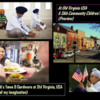Hi all,
Excited to see this group getting started! Thanks to the organizers for the work you've already put into it, and will continue to do so.
I'm a movement organizer, circle keeper, and peacebuilding trainer based in Minneapolis, MN, but also working internationally. I came into peacebuilding through religious work. Through years of working in vulnerable and disenfranchised urban communities, often with people with very different backgrounds and experiences than my own, my priorities and beliefs shifted from telling people about the heaven that might be waiting for them, to working with them to experience "heaven"—shalom, peace, and reconciliation—in our communities. That shifted my focus to community development, interfaith and intercultural dialogue, community organizing, and social justice activism.
In the wake of George Floyd's murder in 2020 and the subsequent uprising in the Twin Cities, my local peacebuilding has focused on different aspects of racial healing and justice work. In my work with Peace Catalyst, I also spend time training people in peace and conflict skills while helping to cultivate a peacebuilding movement in faith communities and neighborhoods.
I'm attracted to the positive, constructive possibilities of conflict—leaning into conflict, welcoming conflict, sometimes even escalating conflict, because we believe there is something better on the other side of it. Conflict is not a problem but an opportunity.
Many traditions embrace this. Peace studies talks about positive and negative peace, the construction of good versus simply ending hostilities. Kingian Nonviolence talks about the Beloved Community, where conflict is present but is handled with love. My peace church traditions understand shalom, peace, as the creation of good in community. Other nonviolence traditions teach the embodied model of "two hands", with one hand extended in invitation, and the other hand held up to stop the harm.
This, I think, is the place where justice intersects with peace. Peace is not peace unless it is a just peace. The work of growing and building peace, of healing hearts and communities and societies, means struggling for justice, equity, and inclusion for everyone, even as we mend relationships and cultivate reconciliation.
Looking forward to connecting more!
